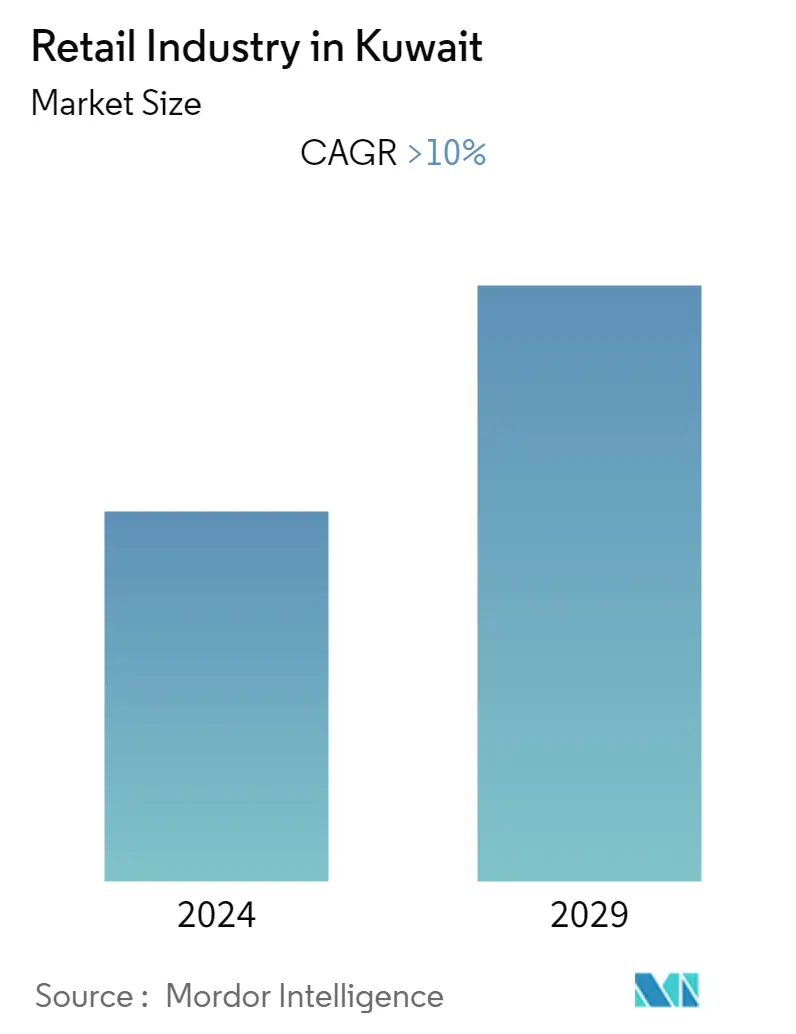Market Size of Retail Industry in Kuwait

| Study Period | 2019 - 2029 |
| Base Year For Estimation | 2023 |
| Forecast Data Period | 2024 - 2029 |
| Historical Data Period | 2019 - 2022 |
| CAGR | 10.00 % |
| Market Concentration | Low |
Major Players
*Disclaimer: Major Players sorted in no particular order |
Kuwait Retail Market Analysis
Kuwait is one of the fastest-growing markets, which is driven by a strong purchasing power vested in Infrastructural projects, the retail industry, and a strong trading and oil industry. Kuwait's retail sector has expanded significantly given the development of shopping malls. Recovering economy coupled with increasing buyer purchasing power, high disposable incomes of middle-class families, and ease of access are driving the retail industry in Kuwait. Moreover, Kuwait has approximately 45% of the population in the 20 to 39 age brackets, and these young consumers have a high inclination towards retail spending in retail malls, and in the purchase of international brands. The internet penetration in Kuwait is one of the highest in the world at 98% as of 2017. This has helped Kuwait's e-commerce market is expanding rapidly as Kuwaitis and expatriates are shopping online.
Kuwait Retail Industry Segmentation
A complete background analysis of the retail industry in Kuwait, which includes an assessment of the National accounts, economy, and the emerging market trends by segments, significant changes in the market dynamics, and the market overview is covered in the report.
| Product | |
| Food and Beverage and Tobacco Products | |
| Personal and Household Care | |
| Apparel, Footwear, and Accessories | |
| Furniture, Toys, and Hobby | |
| Industrial and Automotive | |
| Electronic and Household Appliances | |
| Pharmaceuticals, Luxury Goods, and Other Products |
| Distribution Channel | |
| Stored-based (Hypermarkets and Supermarkets and Department Stores) | |
| Direct Selling | |
| E-commerce | |
| Other Distribution Channels (Drugstores and Organization's Retail) |
Retail Industry in Kuwait Size Summary
Kuwait's retail market is experiencing rapid growth, driven by robust purchasing power and significant infrastructural developments. The sector has seen substantial expansion with the rise of shopping malls, catering to a population with high disposable incomes, particularly among middle-class families. The youthful demographic, comprising a large portion of the population, is increasingly drawn to retail spending, especially in malls and on international brands. The high internet penetration rate has further fueled the growth of e-commerce, making online shopping a popular choice among both Kuwaitis and expatriates. This digital shift is supported by advanced mobile networks and a high rate of smartphone usage, enhancing the convenience and appeal of online retail.
The retail industry in Kuwait is one of the fastest-growing sectors, benefiting from rapid urbanization and a burgeoning expatriate workforce. The market is characterized by a shift in consumer preferences towards international and Western products, influenced by the young and affluent population. E-commerce is poised for further expansion, with companies focusing on improving operational efficiency and diversifying revenue streams through online channels. Major international players dominate the market, but technological advancements and product innovations are enabling mid-size and smaller companies to increase their market presence. The development of advanced online platforms and attractive deals are key factors driving the growth of Kuwait's retail market.
Retail Industry in Kuwait Market Size - Table of Contents
-
1. MARKET INSIGHTS AND DYNAMICS
-
1.1 Market Overview
-
1.2 Drivers
-
1.3 Restraints
-
1.4 Opportunities
-
1.5 Industry Value Chain Analysis
-
1.6 Porters Five Force Analysis
-
1.7 Customer Behaviour Analysis
-
1.8 Insights into the Advertising Strategies of the Leading Players across Segments
-
1.9 Impact of COVID-19 on the Market
-
-
2. MARKET SEGMENTATION
-
2.1 Product
-
2.1.1 Food and Beverage and Tobacco Products
-
2.1.2 Personal and Household Care
-
2.1.3 Apparel, Footwear, and Accessories
-
2.1.4 Furniture, Toys, and Hobby
-
2.1.5 Industrial and Automotive
-
2.1.6 Electronic and Household Appliances
-
2.1.7 Pharmaceuticals, Luxury Goods, and Other Products
-
-
2.2 Distribution Channel
-
2.2.1 Stored-based (Hypermarkets and Supermarkets and Department Stores)
-
2.2.2 Direct Selling
-
2.2.3 E-commerce
-
2.2.4 Other Distribution Channels (Drugstores and Organization's Retail)
-
-
Retail Industry in Kuwait Market Size FAQs
What is the current Kuwait Retail Market size?
The Kuwait Retail Market is projected to register a CAGR of greater than 10% during the forecast period (2024-2029)
Who are the key players in Kuwait Retail Market?
The Sultan Center, Morad Yousuf Behbehani Group, Alshaya Group, Abdul Aziz S. AL-Babtain & Sons Co and Gulf Franchsing Company are the major companies operating in the Kuwait Retail Market.

